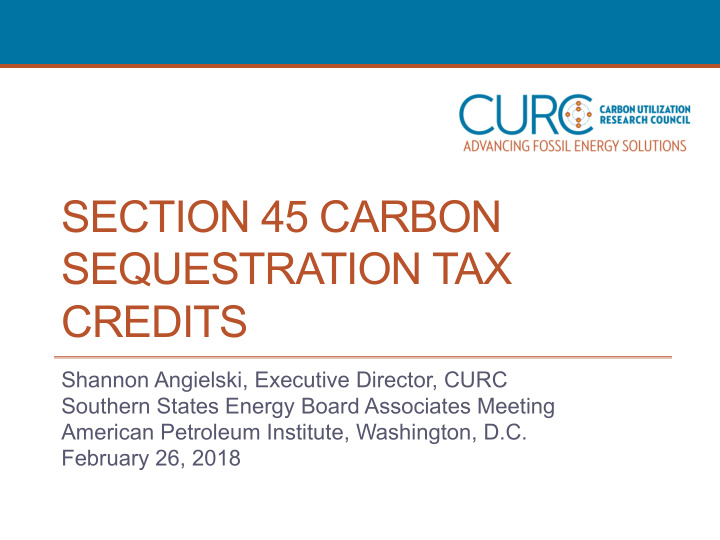



SECTION 45 CARBON SEQUESTRATION TAX CREDITS Shannon Angielski, Executive Director, CURC Southern States Energy Board Associates Meeting American Petroleum Institute, Washington, D.C. February 26, 2018
Carbon Utilization Research Council (CURC) Members Coal Producers Research Organizations Universities Arch Coal, Inc. Battelle Lehigh University Cloud Peak Energy Resources LLC * Electric Power Research Institute (EPRI) Ohio State University Lignite Energy Council Gas Technology Institute Pennsylvania State University Peabody Energy* University of North Dakota Energy & Southern Illinois University Environmental Research Center University of Kentucky/CAER Equipment Suppliers University of Wyoming B&W Power Generation Group, Inc. State Organizations West Virginia University Caterpillar Global Mining Energy Industries of Ohio General Electric* Greater Pittsburgh Chamber of Utilities Mitsubishi Heavy Industries America, Commerce American Electric Power (AEP) Inc. (MHIA) Illinois Coal Association Basin Electric Power Cooperative* Kentucky Energy & Environment Cabinet Duke Energy Services Labor Unions Southern States Energy Board LG & E and KU Services Company United Mine Workers of America West Virginia Coal Association Southern Company* International Brotherhood of Boilermakers Wyoming Infrastructure Authority Tri-State Generation & International Brotherhood of Electrical Transmission Association Workers Technology Developers NET Power NGOs ClearPath Action Trade Associations CoalBlue Project American Coal Council Companies in orange indicate American Coalition for Clean Coal Steering Committee Members Electricity (ACCCE) Edison Electric Institute (EEI) *CURC Leadership Council National Rural Electric Cooperative Association (NRECA) 2
Why 45Q Credits are Necessary l CCUS technology currently costs too much and has yet to be adequately demonstrated on large- scale electric generating systems l As witnessed by the deployment curve with renewable energy technologies, we know that development of improved CCUS technologies and successive application will reduce the cost of these technologies over time l 45Q credits will help offset the costs of adding CO 2 capture to a power generation facility. 3
45Q Background l Originally enacted as part of the Energy Improvement and Extension Act of 2008 l Credit is equal to: • $20 per metric ton for qualified CO2 that is captured and disposed of in secure geological storage or • $10 per metric ton for qualified CO2 that is captured and used as a tertiary injectant in a qualified EOR project l Program is capped at 75 million tons 4
Challenges with Original 45Q Program l ~45 to 50 million of the authorized 75 million tons have already been claimed l Cap creates financial uncertainty because it is unknown if remaining credits will be available when a project begins to inject CO 2 l Credit amounts are insufficient to cover costs of CCUS on power generation and do not stimulate financing of CO 2 capture projects l Eligibility criteria can be restrictive and limiting 5
FUTURE Act, S. 1535 l CURC advocated for enactment of the “ F urthering carbon capture, U tilization, T echnology, U nderground storage, and R educed E missions (FUTURE) Act l S. 1535 included in Bipartisan Budget Act of 2018 l Effort led by Senators Heitkamp (D-ND), Capito (R-WV), Whitehouse (D-RI) and Barrasso (R-WY) 6
Changes Made through the FUTURE Act § Removes cap § Makes credit available through 2024 (commence construction) § Credit claiming period is 12 years § Increases credit values over a 10 year escalation period to: • $35/ton for EOR • $35/ton for CO2 used in non-EOR applications (CO 2 Utilization) • $50/ton for geologic storage § Direct air capture an allowable technology § Proposes assignability to other entities involved in the project § Modifies eligibility criteria: • Shifts from industrial emitter to CO 2 capture equipment owner • CO 2 Thresholds § Maintains 500,000 tons of CO2 for EGUs § 100,000 tons for industrial emitters § 25,000 tons for pilot projects in which the CO 2 is sequestered in a utilization project 7
GHG Reporting Requirements l Original 2008 statute requires that the CO 2 must be used in “secure geologic storage l To be eligible for 45Q tax credits, IRS requires entities to report through the Subpart RR requirements l EPA Subpart RR monitoring requirements apply to: • Class VI wells under the Safe Drinking Water Act; • Existing power plants affected under the CPP; and • New power plants subject to the Carbon Pollution Standards l Subpart UU monitoring requirements apply to Class II wells where the CO 2 is injected for enhanced oil or gas recovery (EOR). l Subpart RR considered to be extremely stringent and have prescriptive CO 2 monitoring requirements that are not conducive for many EOR operations. 8
THANK YOU & QUESTIONS Shannon Angielski sma@vnf.com www.curc.net 9
Recommend
More recommend